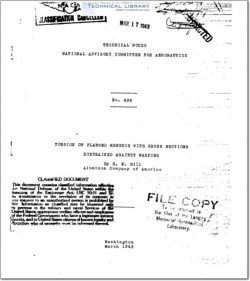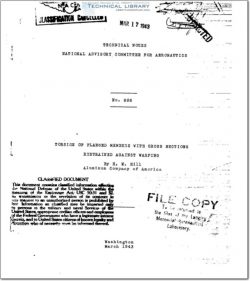NACA-TN-888

- Version
- 564 Downloads
- 1.63 MB File Size
- 1 File Count
- July 13, 2016 Create Date
- July 13, 2016 Last Updated
National Advisory Committee for Aeronautics, Technical Notes - Torsion of Flanged Members with Cross Sections Restrained Against Warping

When pure torque is applied to a flanged member. such
as an I»beam, a channel, or a Z—bar, twisting is accompanied _
by warping of the cross sections._ If one or more cross sec— ‘”
tions are restrained against such warping, longitudinal U
stresses are set up that are generally associated with bend-
ing of the flanges.- In some instances these stresses become
quite large and have_an appreciable effect on the torsional
stiffness of the member. A knowledge of the torsional stiff- _
ness is essential in determining the stability of a member . .~
against torsional buckling under axial compression or against w. a
lateral buckling under beam loading. ':j'
Because of the symmetry of the cross section, the longi~ 1
tudinal stresses resulting from restraint against cross-
sectional warping in a_ twisted I—beam are confined to the
flanges. The stresses may be considered as being produced
by bending of the flanges in their own planes. In the case
of an unsymmetrical section, such as a channel or a 2- -bar,
longitudinal stresses ocCur in the web as well as in the
flanges. In such cases the stress distribution cannot be
determined by Considering only bending of the flanges.
The solution to the problem of the twisting of I-beams.
with restraint against cross~sectional warpingJ may be ob-
tained from many sources. (See, for example, references
1 to 3.) Treatments of the same problem involving flanged
members of unsymmetrical cross section are not so numerous,
although some authorities (references 1 and 2) state that
the formulas for longitudinal stresses and angles of twist
or to Z-hars.” The case of a channel has been handled by
"considering the dress section as composed of two angles
that are constrained to bend about certain axes (reference
4). A method for evaluating the longitudinal stresses and
angle of twist for a member of any "open section" is con—
tained in the works of fiagner (references 5 and 6) and Kappus
(reference 7).
| File | Action |
|---|---|
| NACA-TN-888 Torsion of Flanged Members with Cross Sections Restrained Against Warping.pdf | Download |

Comment On This Post